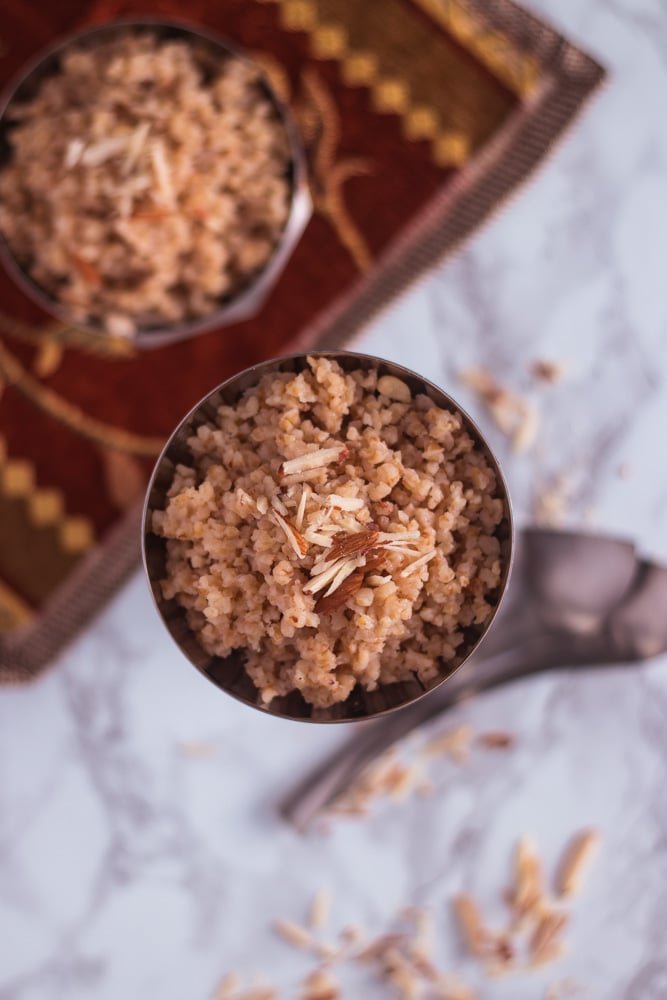If you’re looking for a comforting, hearty, and utterly divine Indian sweet, then this traditional Fada Lapsi is just what you need. Made with simple, wholesome ingredients like cracked wheat (also known as fada or dalia), pure desi ghee, sugar, and delicately infused with the warmth of cardamom, this dish brings together taste, tradition, and nostalgia in one bowl.
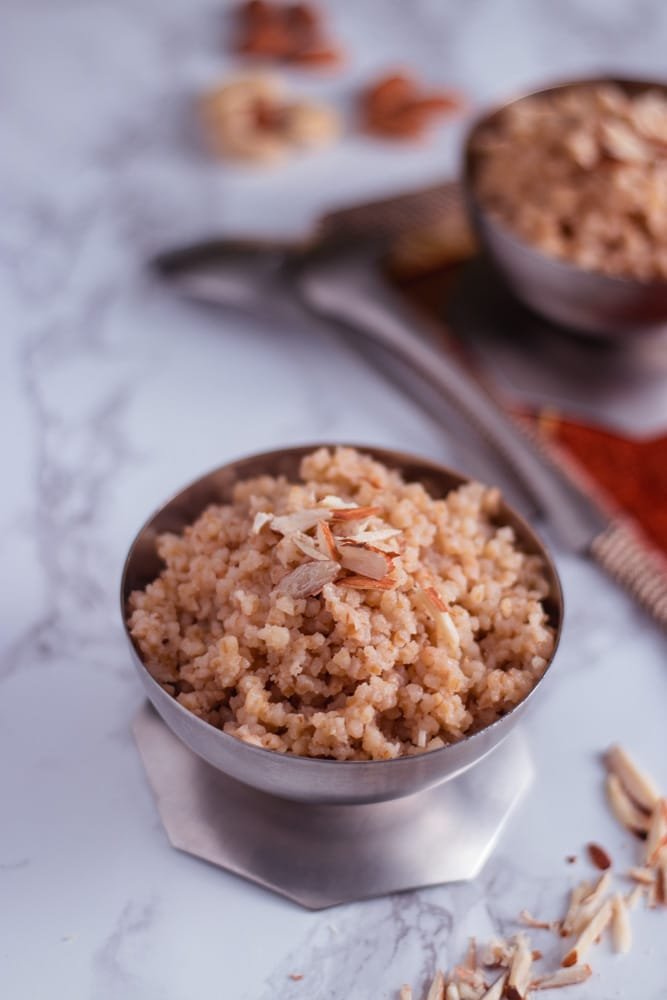
A staple in many Gujarati households during festivals, poojas, and special occasions, lapsi isn’t just a dessert – it’s an emotion. Families serve this sweet dish as prasad during Diwali or to celebrate milestones, making it a cherished part of every celebration.
Slow-cooked to perfection, the cracked wheat absorbs the richness of ghee and the sweetness of sugar, resulting in a melt-in-the-mouth texture with just the right amount of bite. The addition of cardamom powder enhances its aroma, while a generous garnish of sliced almonds and roasted cashews adds crunch and luxury.
What makes this recipe truly special is how effortlessly it comes together. No complex techniques or hard-to-find ingredients – just traditional cooking methods, a little patience, and lots of love. And the reward? Lapsi turns into a fragrant, golden delight that feels comforting, festive, and utterly irresistible with every spoonful.
Whether you’re new to Gujarati cuisine or grew up enjoying this in your grandmother’s kitchen, this is one recipe you’ll return to again and again. So go ahead – bring a taste of tradition to your table with this best-ever fada lapsi recipe. One spoonful, and you’ll know why it’s so cherished!
Gujarati Fada Lapsi Recipe
I’m excited to share my version of this timeless festive dessert that families have cherished and enjoyed for generations.
Deeply rooted in tradition, this warm and hearty sweet dish is especially popular during auspicious occasions and religious festivals such as Diwali, Dhanteras, Raksha Bandhan, Holi, Janmashtami, and even pre-wedding rituals. Often prepared as an offering to the divine, it symbolizes blessings and new beginnings. From joyful birthdays to naming rituals or special achievements like getting a new house or car, lapsi is made to honor the moment with warmth and tradition. lapsi marks the celebration with a touch of sweetness and tradition.
Although Lapsi is especially cherished in Gujarat, its delightful presence extends across many regions of India. This delicious dessert also finds a home in other parts of western India, like Rajasthan and Maharashtra, where it may be prepared with slight variations. Some use jaggery instead of sugar, others may cook it with milk instead of water, but one thing remains constant: the use of cracked wheat (fada, dalia, or broken wheat) as the hero ingredient.
Depending on the region, this dish goes by different names. In Gujarat, it’s lovingly known as Fada ni Lapsi; in Maharashtra, it might be called dalia sheera, lapshi, or cracked wheat sheera – but the sentiment it evokes is the same across all households.
This dish earns widespread love because it perfectly balances nutrition and indulgence. It fills you up, satisfies your sweet cravings, and uses just a few simple pantry staples.
The Star Ingredient – Cracked Wheat
Cracked wheat comes in two textures – coarse and fine. When making fada lapsi, always go for the coarse variety to achieve that signature grainy texture and wholesome bite. Use the fine version for other traditional sweets like kansar, which requires a softer consistency.
Whether you’re introducing this sweet to a younger generation or recreating memories from your own childhood, one thing is certain – this broken wheat dessert has a timeless charm. It’s a comfort dish that appeals to all ages and continues to be a symbol of celebration, joy, and togetherness.
Let’s dive in and create this soulful dessert right in your kitchen!
Ingredients:
- ¼ cup Ghee (Clarified Butter): Use pure homemade or store-bought ghee for a rich aroma and authentic flavor. Ghee is essential as it enhances the nutty taste of the dalia and gives the lapsi a smooth, melt-in-the-mouth texture.
- 1-inch Cinnamon Stick: A small piece of cinnamon infuses the ghee with a warm, mildly sweet-spicy note that complements the earthy taste of the wheat.
- 2 Cloves: Whole cloves add a subtle depth and a hint of spice, balancing the sweetness beautifully.
- 1 cup Dalia (Fada / Broken Wheat / Cracked Wheat / Bulgur): Use coarse-textured dalia for this recipe. It gives the lapsi a hearty bite and classic grainy texture. Avoid using the fine variety, as it’s better suited for other dishes like kansar.
- 3½ cups Hot Water: Pre-heated water helps in faster and even cooking of the dalia, making it soft and fluffy without turning mushy.
- ½ cup Sugar: Regular granulated sugar sweetens the dish just right. You may adjust the quantity slightly depending on personal preference.
- ¼ teaspoon Green Cardamom Powder: Adds a lovely, aromatic flavor that’s traditional in most Indian sweets. Make sure it’s freshly ground for the best fragrance.
- 2 tablespoons Sliced Almonds: Thinly sliced almonds give a slight crunch and richness, making the lapsi more festive and visually appealing.
- 2 tablespoons Chopped Cashew Nuts: Roasted or raw, cashews add texture and richness, making every spoonful more indulgent.
How to make Lapsi Recipe?
1) Warm the Ghee: Place a heavy-bottomed pan or kadai on medium heat. Add the ghee and let it melt completely. As the ghee heats up, gently toss in the cloves and cinnamon to infuse it with flavor. Let them sizzle gently to release their aroma into the ghee.
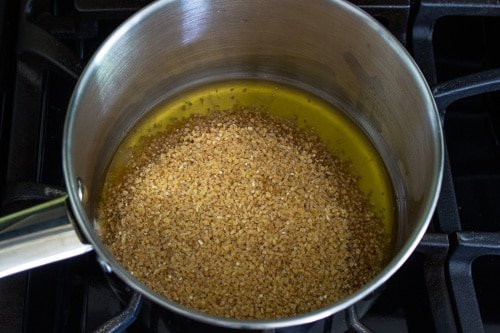
2) Add and Roast the Dalia (Fada): Once the spices have released their aroma, stir in the cracked wheat and coat it well with the ghee. Initially, you’ll notice that the dalia absorbs all the ghee. This is normal and the start of the roasting process.

3) Heat the Water Separately: While the dalia is roasting, heat the measured water in a separate vessel until it reaches a gentle simmer. You can do this on another burner or use a microwave for convenience.
4) Continue Roasting Dalia: Stir the dalia constantly on medium heat to prevent burning. Soon, the grains will become lightly golden and start giving off a deep, roasted scent. As it roasts, you’ll see ghee releasing back and bubbling around the grains. Roasting the cracked wheat to the right level of aroma and color usually requires 5 to 6 minutes.

5) Add Hot Water Carefully: Slowly pour the hot water into the pan with the roasted dalia. Be cautious, as it may splatter. Stir immediately to combine everything.
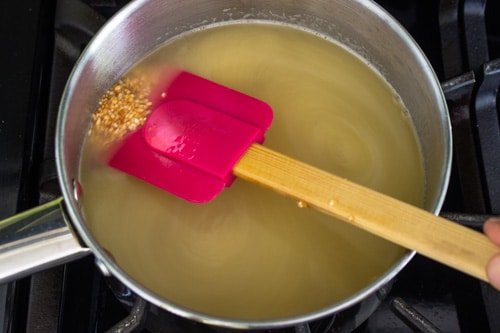
6) Cook Covered Until Soft: Reduce the heat to medium-low, cover the pan with a lid, and let it cook. The dalia will absorb the water and begin to soften.
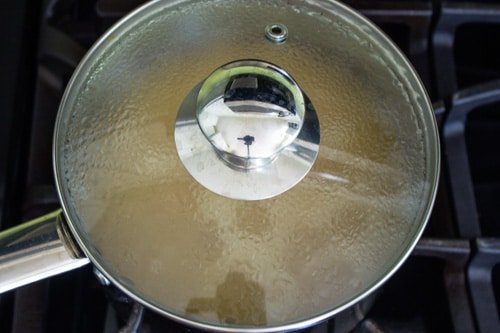
7) Check and Stir Occasionally: Open the lid occasionally to stir and check the progress. If the water is drying up but the dalia is still slightly undercooked, add a little more warm water and continue cooking.
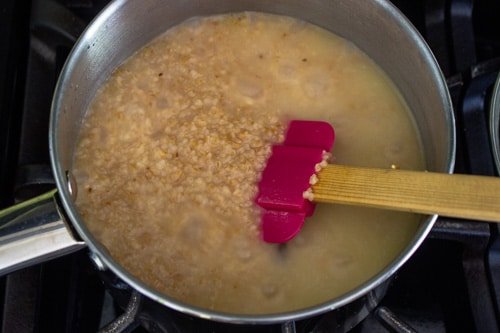
8) After 20 Minutes – Check Texture: Around the 20-minute mark, the dalia should look soft, well-cooked, and fluffy. There may still be a bit of moisture remaining at this stage.

9) Cook Until Moisture Reduces: Remove the lid and stir continuously, allowing the excess moisture to evaporate. The mixture should thicken and begin to look grainy and dry.
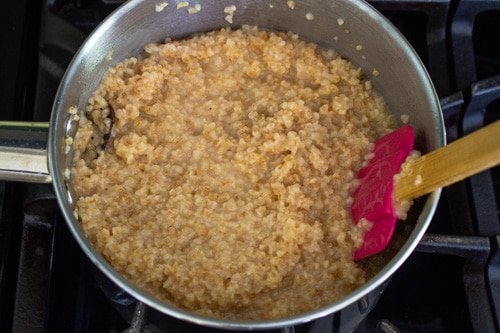
10) Add Sugar and Cardamom: Stir in the sugar and ground cardamom powder. As the sugar dissolves, the mixture will become loose and glossy again. Don’t worry—this is part of the process.

11) Cook Until Dry Once More: Keep stirring and cooking until the sugar syrup is absorbed and the lapsi thickens again. This should take another 5 to 6 minutes. The texture should now be soft yet separate, not sticky.

12) Garnish and Serve: Turn off the heat. Garnish with a handful of sliced almonds and finely chopped cashews for added crunch and richness. Mix gently or leave as a garnish. Serve warm and enjoy this traditional Gujarati sweet, full of flavor and festive spirit!
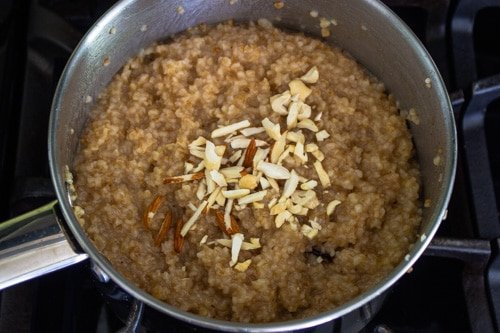
Expert Tips for Perfect Fada Lapsi
1. Choose the Right Type of Dalia: Always use coarse cracked wheat for lapsi. The fine variety is typically used for other dishes like kansar or dalia porridge and won’t give the same texture. Coarse fada gives that signature grainy yet soft bite lapsi is known for.
2. Roast Thoroughly: Roasting dalia in ghee is the foundation of flavor. Don’t rush this step. Stir constantly over medium heat until the dalia turns golden brown and starts releasing a warm, nutty aroma. If the dalia isn’t roasted well, it may taste uncooked and turn out mushy.
3. Use Hot Water: Pouring warm water rather than cold prevents shock to the grains and promotes uniform cooking. Cold water can also cause the ghee to seize, making the mixture uneven.
4. Stir Frequently While Cooking: As the dalia absorbs water and begins to swell, make sure to stir occasionally to avoid it sticking to the bottom. Use a heavy-bottomed pan to distribute heat evenly.
5. Adjust Sugar to Taste: Traditional lapsi is moderately sweet, but you can adjust the amount of sugar according to your preference. Just remember: after adding sugar, the mixture will become watery again—keep cooking until it thickens back.
6. Enhance with Dry Fruits: Roast the almonds and cashews in ghee before garnishing for an even richer flavor. You can also add golden raisins or pistachios for variation.
7. Flavor with Saffron or Rose Water: To give your lapsi a regal flair, include warm milk infused with saffron or a few drops of rose water along with the spice.
